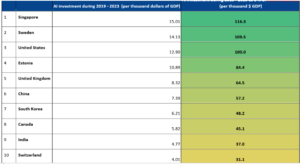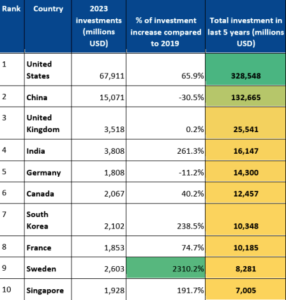Recent reports suggest AI investments are predicted to approach $200 billion globally by 2025, with countries competing to enjoy the benefits artificial intelligence has on productivity and the economy.
Which countries have invested the most in AI between 2019 to 2023? AI statistics from AIPRM compared the investment of each country with the United States, who are currently leading the way for AI investment.
Key findings:
- The United States invests the most in AI, with a total of $328,548 million spent in the last five years.
- When looking at the investment relative to the country’s overall economic output (GDP), Singapore is leading in AI spending, with $15.01 for every thousand dollars of GDP – 16% more than the U.S investment (per thousand $GDP).
Top 10 countries with the most AI investment (2019 – 2023)


(Source: AIPRM via OECD and World Bank)
AI statistics from AIPRM, has found that the United States is the country investing the most in AI, with $328,548 million spent in the last five years. They have invested $67,911 million in 2023 alone, a 65.94% increase from that of 2019.
China places second with $132,665 million spent on AI between 2019 to 2023, around 60% less than the United States. The country’s investment in AI has been slowing down since 2019, totalling $15,071 million in 2023, about a third less than their spending in 2019.
In third place is the United Kingdom with a $25,541 million investment across the same period, almost 13 times less than the US by comparison.
The other tech giant country in Asia, India, ranks fourth place with a $16,147 million investment in AI in the last five years. The country exceeds Germany, who ranks fifth by nearly 13% ($1,847 million).
The country with the most significant growth in AI investment in the past five years is Sweden – an astonishing 2310%!
Please see the full datasheet with 53 countries included here on Onedrive.
Top 10 countries outpacing the U.S in AI investment relative to GDP


When AI investment statistics are judged against the country’s GDP (Gross Domestic Product), Singapore comes out on top. Despite placing tenth in terms of the amount of money spent, their investment over the past 5 years is equivalent to 1.5% of its current GDP (in 2022). When compared to the U.S, their rate of AI investment is outpacing the U.S by 16% per thousand $GDP.
This is followed closely by Sweden whose investment in AI is over 14 dollars per thousand $ GDP – equivalent to 1.4%. They are also the only other nation investing more than the U.S in AI in relative wealth terms (over 9%).
The United States is investing $12.90 per thousand $GDP (1.29%), followed by Estonia who is investing $10.89 per thousand $ GDP (1.089%).
Please see the full datasheet with 53 countries included here on Onedrive.
Methodology
- AI statistics from AIPRM wanted to find out which countries in the world have invested the most in AI in the past five years (2019 – 2023).
- To do this, they first collected data from OECD, which estimates venture capital financial investment (i.e. investments in business startups) in AI based on data sourced from Preqin. The data show which countries are attracting investments from interested parties.
- Investment data was then compared to the country’s GDP as of 2022, allowing a more fair comparison to be drawn between all the countries. This was done by calculating the investments of the past five years per capita (per $1 thousand USD).
- Finally, for each country, these investments per capita were calculated as a percentage of USA investments per capita, to show which countries are ahead/are behind the USA in terms of AI investment. E.g. China is at 57%, therefore it’s around half the USA investment per capita.
- Data from the past five years was used. Any country missing data from these years was excluded. Israel data has been removed from the ranking due to ongoing conflicts.
- All data was collected in dollars and the currency exchange rate was taken on 12th December, 2023.
- Data was collected in December 2023 and is correct as of then.
Source: AI statistics































